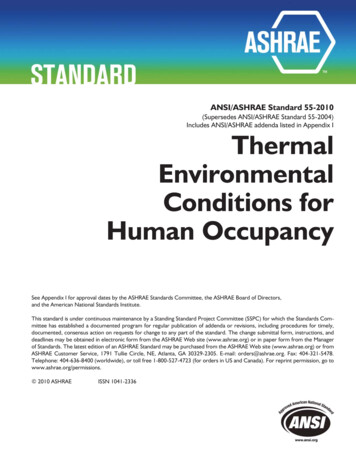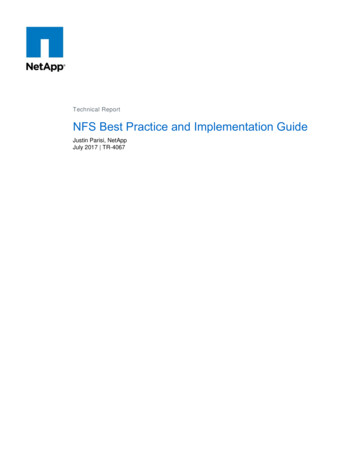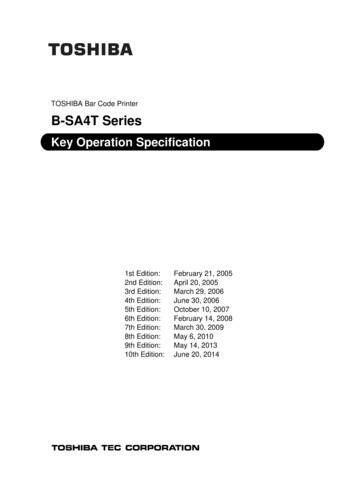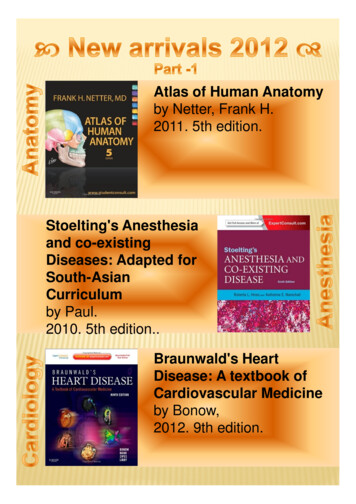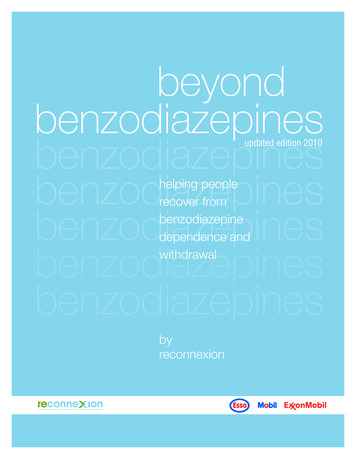
Transcription
ted edition 2010helping peoplerecover frombenzodiazepinedependence andwithdrawalbyreconnexion
Reconnexion IncRevised Edition 2010Reconnexion222 Burke RoadGlen Iris 3146 61 3 9886 9400www.reconnexion.org.auISBN 978 0 646 32895 6
acknowledgementsThe 2010 version of the Beyond Benzodiazepines Manual has been revised from the originalmanual developed in 1997 by Elin Ree and updated in 2000.The 2010 revision of the Beyond Benzodiazepines manual was undertaken by Tomi Redman(Reconnexion psychologist) and Gwenda Cannard (Reconnexion CEO).Review of the draft and additional input was provided by Jo Marston (Reconnexion psychologist).Thanks to Janet Haynes (Education & Training Manager, Reconnexion) and Laurence Hennessy(Project Officer, Reconnexion) for useful comments.Thanks to the Psychotropic Expert Group, Therapeutic Guidelines Limited for permission to usethe Comparative Information for Benzodiazepines, Zolpidem and Zopiclone table in Chapter Four.Helpful feedback and comments for the original manual which have been retained in the revisedversion were provided by Therese Barry (Alcohol & Drug Counsellor, Western Region CommunityHealth Centre), Dr Robert Cummins (Deakin University), Hilde Edward (Swinburne University),Lisa Frank (University of Melbourne), Melanie Hands (Project Manager, Drug & Alcohol ClinicalAdvisory Service, Turning Point Alcohol & Drug Centre), Terrie Hollingsworth (Counsellor, SunburyCommunity Health), Dr Peter Johnson (GP), Dr Len Klimans (Chemical Dependency Unit, RoyalWomen’s Hospital), Dr Nic Lintzeris (Turning Point Alcohol & Drug Centre), Dr Mike McDonough(Consultant, ST Vincent’s Alcohol & Drug Program, Western General Hospital Alcohol & DrugProgram), Peter McManus (Secretary, Drug Utilisation Sub Committee, Pharmaceutical BenefitsScheme, Department of Health & Ageing), Dr Robert Moulds (Director, Department of ClinicalPharmacology & Therapeutics, Royal Melbourne Hospital), Jackie Shaw (Manager, Depaul House,St Vincent’s Hospital, Melbourne), Lyn Walker (Manager, CASA House, Royal Women’s Hospital,Melbourne) and Dr Sally Wilkins (North East Melbourne Psychiatric Services, Department ofHuman Services, Victoria).Reconnexion is grateful for the support of ExxonMobil Australia for once again enabling therevision and update of the Beyond Benzodiazepines Manual.ExxonMobil AustraliaExxonMobil Australia is pleased to support Reconnexion to produce the manual BeyondBenzodiazepines –helping people recover from benzodiazepine dependence and withdrawal.The information about benzodiazepines use, dependency and withdrawal will be of interest to arange of health practitioners.The manual was first produced in 1997 in recognition of the need for information to assisthealth practitioners understand benzodiazepine dependency and support people through therecovery process. The initiative has been a great success and ExxonMobil’s support has enabledReconnexion to revise and reprint the manual in 2000 and again in 2010.ExxonMobil actively supports community projects in areas where it operates through its subsidiarycompanies Esso Australia Pty Ltd and Mobil Oil Australia Pty Ltd. ExxonMobil’s ContributionsProgram gives priority to projects that promote community health, safety and education.Further information about ExxonMobil Australia operations and community projects is availableat www.exxonmobil.com.au
the beyondbenzodiazepines manualWho is this manual for?The manual is designed for health practitioners to assist people who are dependent onbenzodiazepines. It will be useful for: Alcohol and drug practitioners Counsellors Community health nurses Psychologists Social workers Youth workersThe manual is designed to provide information about benzodiazepine use, dependency andwithdrawal. The manual provides a guide to benzodiazepine reduction and withdrawal supportthat will enable practitioners to successfully help people through the recovery process.Benzodiazepines are still prescribed and used inappropriately and long term, even thoughprescribing has reduced to some extent since their introduction and use in the 1960’s and 1970’s.Tolerance and dependence on benzodiazepines can occur within weeks, and iatrogenicdependence (ie dependence as the result of prescription for legitimate purposes) is widespread.Use of benzodiazepines in association with illicit drug use is commonplace, with the concomitantproblems relating to obtaining the supply of benzodiazepines from GP’s, as well as difficulties insupporting dependent people through benzodiazepine withdrawal in addition to withdrawal fromother drugs.Due to the potential severity of withdrawal symptoms, the fear of coping without the drug orthe unresolved issues that long-term drug use has masked, many people require professionalassistance to reduce or stop their benzodiazepine use.Who can you contact for additional informationand assistance?Reconnexion is a not for profit organisation specialising in treating benzodiazepine dependency,anxiety disorders and depression; established in 1986 as TRANX. Part funding is provided by theDepartment of Human Services, Victoria.Reconnexion counselling staff members are available to provide specific advice about anyproblems or difficulties you may encounter assisting people dependent on benzodiazepines.The Reconnexion Telephone Information and Support Service is available for people experiencingbenzodiazepine withdrawal.the beyond benzodiazepines manualWhy is this manual necessary?Additional resources are listed in the resources & handouts section of the manual.1
about benzodiazepinesabout benzodiazepines
CHAPTER ONEabout benzodiazepinesWhat are benzodiazepines?Benzodiazepines are psychotropic drugs, that is, drugs that affect the mind and are mood altering.They are also known as minor tranquillisers, anti-anxiety medication, sedatives and hypnotics and areprescribed predominantly for anxiety and sleeping problems. It is now well recognised that there is asignificant risk of dependence on benzodiazepines when taken regularly, and recommended lengthof use is for no longer than two to three weeks of daily use.Psychotropic drugsConfusion often exists between benzodiazepines and other psychotropic drugs. Information aboutbenzodiazepines is not applicable to other psychotropic drugs, therefore it’s very important thatpractitioners are sure about the type of drug a person is taking before providing information or advice.Common psychotropic drugs (other than benzodiazepines) are: antipsychotics antidepressants sedative hypnotics (not in the benzodiazepine group) drugs for specific conditions such as bi-polar mood disorder (formerly known as manic depression).Benzodiazepines available in AustraliaA large number of benzodiazepines are available on prescription in Australia. The most commonones are Temazepam , Xanax and Valium. The following table provides a list of currently availablebenzodiazepines. (2009)Generic NameGeneric NameBrand NameXanaxKalmaAlpraxAlprazolam-DPGenrx xGenrx tent of benzodiazepine prescribing and useBenzodiazepines are amongst the most commonly prescribed drugs in Australia. It is estimatedthat more than eight million prescriptions were issued in 2004 (Pharmaceutical Benefits AdvisoryCommittee 2007).The National Health Survey 2007/8 reported that 37% of people had taken some medications formental well being (including vitamins & minerals). Of these people, 72% had taken antidepressants,27% sleeping tablets and 23% for anxiety or nerves.about benzodiazepinesBrand Name3
More women than men reported taking medication.Older people took more medication but this was largely due to the use of sleeping pills, which forolder people over 65 was 11%, compared with 5% for the whole adult population.Temazepam was the most commonly used benzodiazepine.Why are benzodiazepines prescribed?Most prescriptions for benzodiazepines are written to help people cope with anxiety or insomniawhich are often associated with social or personal problems.Prescribing for insomnia is most common, especially for older people (over 65 years).People suffering from panic attacks and agoraphobia are also frequently prescribedbenzodiazepines.Benzodiazepine prescribing and use Older people in residential care are more likely to be prescribed benzodiazepines than thoseliving at home. Women receive approximately twice as many scripts for benzodiazepines than men. Use among young homeless people, often in combinations with other drugs, is common. Benzodiazepines are frequently used with other drugs such as heroin, alcohol, methadone andamphetamines.How do benzodiazepines work?about benzodiazepinesBenzodiazepines are: Absorbed in the stomach and small intestine and metabolised by the liver (when taken orally) Highly fat soluble and accumulate in fatty tissue Excreted through sweating, saliva, urine, faeces and breast milk.4Benzodiazepines and the central nervous systemBenzodiazepines operate widely in the brain. They affect emotional reactions, memory, thinkingand control of consciousness. They also affect the regions of the brain that maintain muscle toneand coordination. Benzodiazepines enhance the action of a neurotransmitter in the brain known asGABA (Gamma Amino Butyric Acid).Neurotransmitters are chemicals that enable the brain cells to transmit impulses from one toanother. They are released from brain cells by electrical signals. Once released, they signalinhibition or excitation of neighbouring brain cells.GABA is the major inhibitory neurotransmitter. Its function is to slow or calm things down.Benzodiazepines increase the efficiency of GABA, thus causing greater inhibition.
Benzodiazepine binding sitesDr Heather Ashton. Anything for a quiet life? New Scientist 1989. Reproduced with permission.Benzodiazepine binding sites (see diagram above) are most commonly found in the areas of thebrain controlling our consciousness, coordination, emotions, memory, muscle tone and thinking.The location of the binding sites may explain the significant effects of benzodiazepines in theseareas and why these functions are often severely affected during withdrawal.What are the effects of benzodiazepines?Although benzodiazepines are often categorised as either sleeping pills or anti-anxiety agents,they all have the same basic effects – in the short term their sedative action relieves anxiety andpromotes sleep. The main difference between the drugs is their strength and length of action inthe body.Length of actionShort acting benzodiazepines (half life 6-12 hours)AlprazolamOxazepamTemazepamTriazolam(very short 6hours)Medium acting benzodiazepines (half life 12-24 hours)BromazepamLorazepamLong acting benzodiazepines (half life 24 zepamInformation reproduced with permission from Psychotropic Expert Group. Therapeutic guidelines:psychotropic. Version 6. Melbourne: Therapeutic Guidelines Limited; 2008. p. 24.about benzodiazepinesBenzodiazepines have a complex metabolic structure. They are short, medium and long acting –depending upon the metabolic structure of each drug. The following table identifies long, mediumand short acting benzodiazepines.5
Length of action is also influenced by other factors such as the health of the liver, age and weight,and short acting benzodiazepines may last as long as the long acting drugs in some people.In prescribing practice, the shorter acting benzodiazepines are usually prescribed as sleepingpills and the longer acting ones for the alleviation of anxiety. This is because the longer actingbenzodiazepines have a generalised effect on anxiety, whereas short acting benzodiazepineshelp promote sleep without giving a ‘hangover’ effect the next day. Other factors such as the ageof the patient and common usage of a particular brand may also influence which benzodiazepinea doctor will prescribe.Strength of individual benzodiazepinesThe milligram amount of each benzodiazepine varies and is not indicative of the strength of thedrug compared with other benzodiazepines. For example, Alprazolam is available in 0.5 mg up to2mg, but this does not mean that it is weaker than, for example, Oxazepam which is available in15mg and zepamTemazepamTriazolamStrength(s) available in0.25mg, 0.5mg, 1mg, 2mg3mg, 6mg10mg0.5mg, 2mg2mg, 5mg1 mg1mg, 2.5mg5mg15mg, 30mg10mg0.125mgabout benzodiazepinesHow effective are benzodiazepines?6Anxiety and anxiety disordersBenzodiazepines quickly relieve the symptoms of anxiety with few side effects for most people.However, the long-term effects of anxiety reduction remain debatable. No reliable research existsto demonstrate anxiety reducing properties of the drug after four months, even though manypractitioners argue that such therapeutic effects are present for many years. The risk associatedwith using benzodiazepines long-term is that the person may become physically dependent onthe drugs.Physical dependency can often mean a paradoxical increase in anxiety. Anxiety and panic arecommon withdrawal effects of benzodiazepines and if not correctly identified as such, can leadthe person to conclude that the initial anxiety is still present or has worsened.Research suggests that anxiety disorders are best treated with psychological strategies such ascognitive behavioural therapy (CBT) which is generally more effective in treatment and preventionof relapse than drug use.If drugs are recommended, then specific antidepressants may be effective for some anxietydisorders without the same risk of dependency as the benzodiazepines.(Anxiety disorders include panic disorder, agoraphobia, social phobia, post traumatic stressdisorder, obsessive compulsive disorder, generalised anxiety disorder and health anxiety.)
InsomniaIn the short-term, benzodiazepines induce sleep in approximately 50 per cent of cases. Thetherapeutic effects of the sleep inducing action of benzodiazepines are short lived, however– about one to two weeks. As there is a risk of dependency associated with the long-term useof benzodiazepines, insomnia shouldn’t be viewed as a diagnosis, but as a symptom requiringfurther investigation. Research into the causes of insomnia concludes that benzodiazepines haveno value in the treatment of sleep disturbances and that long-term benzodiazepine use actuallyworsens the quality of sleep. Long-term benzodiazepine use (over a number of months or years)results in less time in the deep sleep stage, less REM or dreaming sleep and more frequentwaking during the night.In older people, changes in circadian rhythm may mean a tendency to wake up earlier and feelsleepy earlier in the evening. Older people in general tend to have more fragmented sleep,with less time in the deep sleep phase. Although excessively prescribed to older people,benzodiazepines don’t correct these physiological changes.NB Sleeping pills or hypnotics that are not benzodiazepinesA number of hypnotics are available that are not benzodiazepines. Zolpidem (Stilnox) andZopiclone are among the most well known of these sleeping pills.The same “safe use” rules apply to the use of these drugs as to the benzodiazepines – that is,the drugs are recommended for short term use only (2-3 weeks maximum) and there is a risk ofdependence with longer term use.Sleep problems warrant proper investigation and diagnosis to determine the type and cause, andare most successfully treated using behavioural strategies. (See Reconnexion’s “The Better SleepBooklet” under resources and handouts)Harm related to benzodiazepinesAlthough benzodiazepines relieve the symptoms of anxiety and insomnia in the short-term, theydo not cure the problem and have a number of unwanted and potentially harmful effects.Additional harmful effects include: Impaired memory and concentration Emotional ‘anaesthesia’ (being unable to respond normally and feeling isolated or ‘cut off’ frompeople and feelings) Depression Loss of balance Impaired motor coordination Mood swings Irritability and outbursts of rageLong term harmful effectsResearch suggests that cognitive impairment (short term and working memory problems anddifficulty learning new information) is a result of long term benzodiazepine use.about benzodiazepinesBenzodiazepines, even in small doses taken regularly for a few weeks, can produce toleranceand dependence. For people using the benzodiazepines for months or years, the risk of drugwithdrawal is significant and the withdrawal syndrome can be painful and protracted.7
Harmful effects for older peopleOlder people may experience a number of unwanted effects in addition to dependency. Usingbenzodiazepines long term can cause older people to suffer from: Loss of balance Falls Confusion and memory loss Drug accumulation and over sedation (the slower metabolism of an older person can mean thatthe drugs take up to four times the amount of time to eliminate from the body than for youngerpeople) Increased urinary incontinence Depression Disturbance in sleep patterns Respiratory problems.Benzodiazepine overdoseLarge quantities of benzodiazepines taken with other central nervous system depressant drugs,such as alcohol or heroin, can result in death.Death can also occur when large amounts of benzodiazepines only are taken, if the airwaybecomes obstructed. Obstruction of the airway usually occurs by inhaling vomit whenunconscious.Benzodiazepines, pregnancy and the newborn childBenzodiazepines freely cross the placenta to the developing foetus. Studies examining the risk tofoetal development are inconclusive; however it would appear that the risk is relatively low.about benzodiazepinesIf moderate to large amounts of benzodiazepines are taken continuously during most of thepregnancy, withdrawal symptoms can be experienced by the baby following birth. Withdrawalsymptoms consist of respiratory distress, irritability, disturbed sleep patterns, sweating, feedingdifficulties and fever.8High benzodiazepine use during the later stages of pregnancy can lead to floppy infantsyndrome. A newborn child with floppy infant syndrome has poor muscle tone and suckingresponse.Continuous benzodiazepine use during pregnancy and administration of high doses duringdelivery should be avoided.Pregnant women using benzodiazepines should withdraw slowly in consultation with expert,specialised medical assistance. Contact Reconnexion, specialist maternity units (available atmost maternity hospitals) or the Royal Women’s Hospital (Melbourne) for specialist advice onpregnancy, birth and benzodiazepine withdrawal.
Combining benzodiazepines with other drugsAlcoholUsing benzodiazepines and alcohol together can be dangerous. Alcohol increases the effects of benzodiazepines Alcohol combined with benzodiazepines can cause temporary amnesia (“blackouts”) The effects of both drugs on inhibition can jeopardise the safety of the person taking them When combined with benzodiazepines, alcohol decreases the protective upper airway reflexes,which increases the risk of inhaling vomit when unconscious.MethadoneA significant number of methadone users also use benzodiazepines. Many people on methadoneprograms are using benzodiazepines long-term which may have been prescribed or obtainedwithout prescription, to alleviate symptoms of discomfort or heighten the effect of methadone. Manymethadone users are dependent on benzodiazepines.The combination of benzodiazepines and methadone increases the effects of the drugs and the risk ofaccidental overdose.Heroin and amphetaminesA number of Australian and overseas studies indicate that a significant number of heroin andamphetamine users regularly take benzodiazepines. Clinical studies have shown that among peoplewith a history of regular and heavy illicit drug use, benzodiazepines exert a reinforcing effect, withrepeated doses leading to an increasing attraction to the drug.The combination of heroin and benzodiazepines increases the effects of the drugs and the risk ofoverdose.Studies have shown that people using benzodiazepines in addition to heroin are more likely to partakein risk taking behaviour (such as sharing needles and syringes or engaging in unsafe sex) whichincreases their risk of contracting Hepatitis C or HIV/AIDS. It is difficult to determine, however, whetherthe benzodiazepines contribute to the risks or whether risk- taking injecting drug users are more likelyto use benzodiazepines.Other drugsThe effect of benzodiazepines may be increased when combined with: Antipsychotic drugs Antidepressant drugs Analgesics (pain relievers) containing Codeine Anticonvulsants Antihistamines Oral contraception.Benzodiazepines are sometimes prescribed for psychiatric disorders in conjunction with an antipsychotic drug in order to enhance the effect of the anti-psychotic.The effect of benzodiazepines is decreased when combined with appetite suppressants and someasthma drugs because of the stimulant effect.about benzodiazepinesAmphetamine users are most likely to use benzodiazepines when they are ‘coming down’.It is possible that amphetamine users may unintentionally take dangerously large amounts ofbenzodiazepines because the effect is not felt straight away due to the presence of theamphetamines.9
Use of benzodiazepinesBenzodiazepines have a number of common medical uses, including being used: As a muscle relaxant For endoscopy procedures As an anaesthetic or a pre-med before surgery or chemotherapy To assist with acute alcohol or drug withdrawal (in residential care under medical supervision) To treat epilepsy (usually where other medications have not been effective) In palliative care.Appropriate benzodiazepine use could include: One or two nights’ use for prolonged sleeplessness when all other methods have failed andprovided that the insomnia is not due to circadian rhythm disturbance or a chronic sleepproblem (appropriate use could be for recent grief or acute stress) Insomnia due to jet lag Severe and acute muscle spasm where conventional methods like massage have not eased thespasm Severe and acute recent anxiety if no other appropriate support is available or while counsellingsupport is arrangedSafe and appropriate use of benzodiazepinesIf benzodiazepines are necessary a prescription should be for: a limited length of time – a few days only and not exceeding two weeks Intermittent use – if used occasionally there is no risk of dependencyabout benzodiazepinesIf a prescription is warranted, information should be provided about: The potential risk of dependency and withdrawal if used for longer than a few weeks Effects on the emotions and the possible impairment of concentration and memory The possibility of rebound insomnia and anxiety when ceasing to use benzodiazepines Effects when used with other drugs Risks associated with driving or working with heavy machinery.10Benzodiazepines should not be prescribed for people currently using excessive amounts ofalcohol or illicit drugs.
identifying benzodiazepine dependencyidentifyingbenzodiazepinedependency
CHAPTER nes are very addictive – tolerance and dependence can occur within weeksof continuous use. It is estimated that 50-80% of people regularly taking low doses ofbenzodiazepines for longer than a few months will develop a physical tolerance to the drug andbecome dependent.DependencyDrug dependence usually has physical and psychological elements. People who are dependenton benzodiazepines may: Feel unable to cope without the drug Find it extremely difficult to stop taking the drug Find that the drug no longer has the same effect and will increase the dose or drink alcohol toachieve the same effect Perceive that they need the drug to function normally Have withdrawal symptoms if the drug is cut down or stopped Crave for the drug.The development of dependencyNot everyone who takes benzodiazepines on a daily and long-term basis will become physicallydependent, although they are at a high risk of dependency.Some people taking benzodiazepines don’t realise that they are dependent until they stop a doseor try to cut down and experience withdrawal symptoms.Unless people are well informed about the risks associated with continuous use, they are likely tocontinue to use the drugs long term and hence develop dependency.Most people initially receive a script to help them cope with anxiety or insomnia associated witha crisis (such as a death in the family, marriage break-up or a combination of things which makesthe person feel that he or she is unable to cope).In the short-term, benzodiazepines are very effective in relieving the symptoms of anxiety andpromoting sleep. People using them will feel much better and will often choose to continue usingthe drug because they have not been informed of the risks.identifying benzodiazepine dependencyAs the lack of recognition of benzodiazepine dependency is common, it often goes undetectedor is misdiagnosed. Be alert for dependency, even though it may not be initially identified as aproblem.11
Over time, a physical tolerance to the drug develops. It feels like the drug is wearing off. Trying toachieve the same effects as before, people may increase their dose or change brands.After a while the drugs no longer stop the symptoms of anxiety or insomnia and people usuallystart to feel a lot worse. At this stage, cutting down or trying to stop taking the drugs makespeople feel a high level of anxiety and other physical symptoms like rebound insomnia. It’scommon for people to resume their dose, mistaking the anxiety or insomnia associated withwithdrawal for their original problem.People can experience withdrawal symptoms while still taking their benzodiazepines. Manypeople have exhaustive tests for their ongoing physical symptoms and when the tests show anegative result, they sink deeper into despair – sometimes assuming that they must be goingmad. Depression, suicidal thoughts, paranoia and occasionally even hallucinations are withdrawalsymptoms, and many people are referred to psychiatrists.identifying benzodiazepine dependencyPeople suffering benzodiazepine withdrawal symptoms feel as if they are always sick, have noself-confidence and have lost all their former skills. They may leave their jobs because they cannotmanage and withdraw socially. Afraid to be left alone, they may keep their children home fromschool, and simple activities like doing the supermarket shopping or making minor decisionsbecome almost insurmountable tasks. Suicide is often contemplated.12Psychologically and physically dependent on benzodiazepines, people feel unable to cope orsurvive without taking their tablets. The increasing decline in physical and mental health has notbeen associated with their long-term benzodiazepine use and they rely more than ever on theirdrugs to help them cope. Without information on the long-term effects of benzodiazepines, peopleassume that their mental and physical distress is related to their original problem.How do you identify if someone is dependenton benzodiazepines?Long-term benzodiazepine users who answer yes to one or more of the following questions maybe benzodiazepine dependent.1. Have you taken sleeping pills or tranquillisers each day or night for six months or longer?Most people taking benzodiazepine for longer than six months are taking them to prevent theonset of withdrawal symptoms rather than for any therapeutic effect. (Benzodiazepines are onlyeffective for sleep for the first 3-7 nights, while there is not adequate research to suggest thatthe anxiety relieving properties of benzodiazepines are effective for more than 4-6 months.)2. Have you ever increased your dose or felt that you needed to increase the dose to have thesame effect as when you first took the benzodiazepines? Have you ever changed brands forthe same reason?Increasing the dose and trying other brands of benzodiazepine in an attempt to achieve thesame feeling as when the drugs were first taken is a good indication that the body has becometolerant to the drug and therefore the person taking the benzodiazepine needs an increase indosage or a stronger drug to achieve the same effect.3. Have you ever tried to cut down or stop your benzodiazepine use?Some people aren’t able to cut down or stop their benzodiazepine use even though they’vemade numerous attempts. This is usually due to the discomfort of withdrawal symptoms.However, it might be related to the initial reason the person was prescribed the drug. Carefulquestioning may be necessary to understand what the person is actually experiencing. Thiscan sometimes be difficult as increased anxiety and insomnia are the most common withdrawalsymptoms.
4. If you have missed a dose of your benzodiazepine, have you felt ill or highly anxious?People missing a dose and feeling agitated, sweaty, sick or unable to sleep will often see thisas a reason to quickly start taking their dose again because they ‘need’ the tablets. Usually,however, it is an indication of benzodiazepine withdrawal.5. Are the effects of the benzodiazepines interfering with your life in some way? Are you, forexample, missing work regularly, having family or relationship problems, experiencing difficultyin coping or remembering things?People who have taken benzodiazepines for a long-term period may not have made theconnection between the deterioration of their abilities and relationships with the long-term useof drugs.6. In addition to your b
The 2010 version of the Beyond Benzodiazepines Manual has been revised from the original manual developed in 1997 by Elin Ree and updated in 2000. The 2010 revision of the Beyond Benzodiazepines manual was undertaken by Tomi Redman (Reconn
